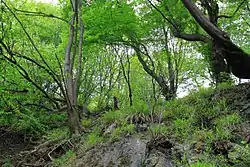Talysh Mountains
Talysh Mountains (Talysh: Tolışə Bandon, Persian: کوههای تالش, romanized: Kuhhâye Tâleš; Azerbaijani: Talış dağları) is a mountain range in far southeastern Azerbaijan and far northwestern Iran within Ardabil Province and Gilan Province.[1]

_Tal%C4%B1%C5%9F_da%C4%9Flar%C4%B1_088.jpg.webp)
They are a northwestern subrange of the Alborz Mountains that run along the southern Caspian Sea on the Iranian Plateau.
Geography
The Talysh Mountains extend southeastward from the Lankaran Lowland in southeastern Azerbaijan to the lower part of the Sefid Rud (White River) in northwestern Iran.
A few peaks rise above 10,000 ft (3,000 m).
Geology
Geologically, the Talish Mountain Range is made mainly of the Late Cretaceous volcano-sedimentary deposits with a strip of Paleozoic rocks and a band of Triassic and Jurassic rocks in the southern parts, both in a north-west-southeast direction.[2]
Ecology
The maximum annual precipitation in the Talysh Mountains is between 1,600 mm to 1,800 mm, which along the Lankaran Lowland is the highest precipitation in both Azerbaijan and Iran. The humid semi-subtropical coastal lowlands along the Caspian Sea, including the Lankaran Lowland, lie at the eastern base of the mountains.[3]
The Talysh Mountains are covered by lowland and montane forests. The area is part of the Caspian Hyrcanian mixed forests ecoregion.[4]
The Caspian tiger used to occur in the Talysh Mountains.[5]
Gallery
See also
- Lankaran Lowland — see for map of range
References
- Microsoft Encarta World Atlas 2001, Microsoft Corporation
- Geological Map of Iran, National Geoscience Database of Iran, www.ngdir.ir
- Encyclopædia Britannica
- "Caspian Hyrcanian mixed forests". Terrestrial Ecoregions. World Wildlife Fund.
- Heptner, V. G.; Sludskij, A. A. (1992) [1972]. "Tiger". Mlekopitajuščie Sovetskogo Soiuza. Moskva: Vysšaia Škola [Mammals of the Soviet Union. Volume II, Part 2. Carnivora (Hyaenas and Cats)]. Washington DC: Smithsonian Institution and the National Science Foundation. pp. 95–202.


